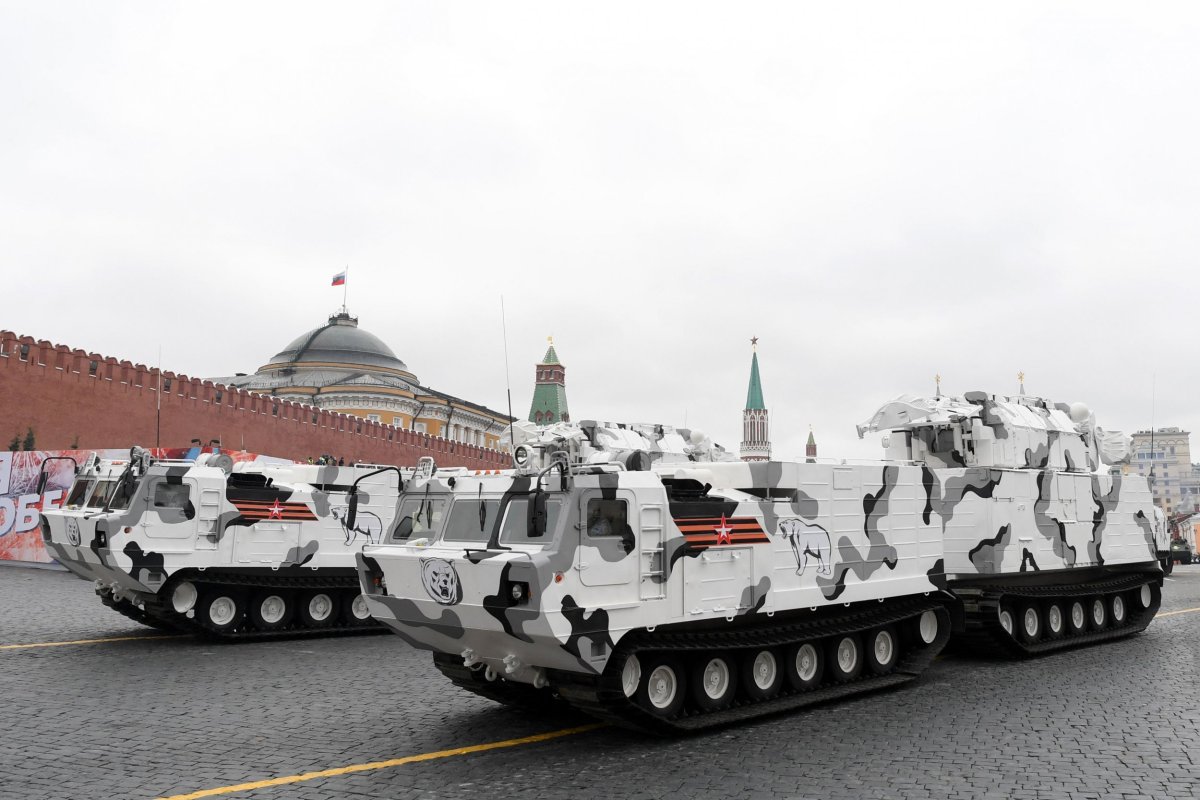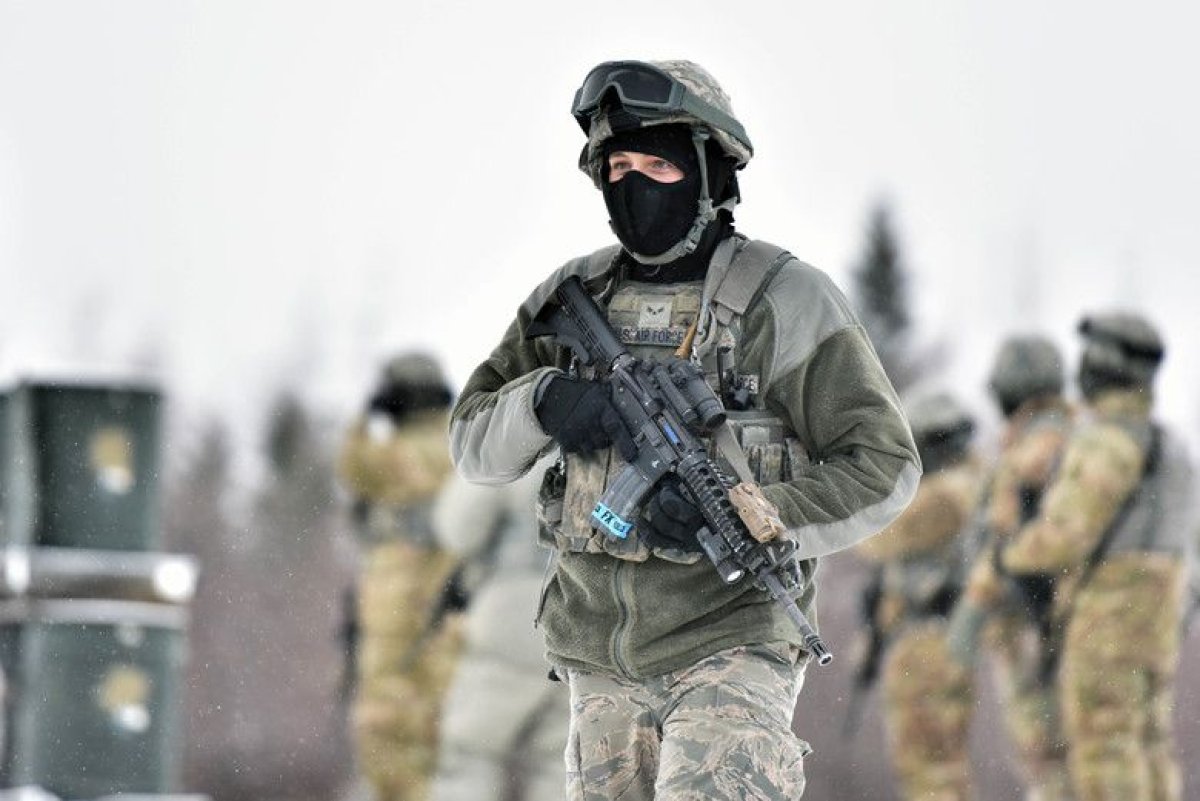The Russian military has received the first batch of a missile system designed specifically to be deployed in the Arctic, where the United States and other world powers have increasingly sought to assert their footprint.
Russia's Defense Ministry said that the country's armed forces adopted their first Tor-M2DT anti-aircraft missile systems, a weapon capable of handling the extreme temperatures and terrain of the Arctic region. Debuted during May 2017's Victory Day parade in Moscow, the equipment is a white-and-gray-camouflaged update to the Tor M2 systems and was said to have a range of up 15 kilometers (9 miles).
The front of the DT-30PM transporter chassis that carries the weapon was also seen adorned with a bear, a longstanding symbol of Russia and its growing military might. On Wednesday, Russian President Vladimir Putin sent a message to the Moscow Federal Arctic Forum emphasizing the importance of the strategic region.
"The Arctic plays a strategic role for Russia. Today, we are reinforcing our presence in the region, implementing scientific research initiatives and large programmes for commercial and economic development, and turning our ambitious infrastructure projects into reality," Putin's message read. "We are also well aware of the importance of preserving the environment and the natural diversity of the polar and subpolar territories."

As effects of climate change were linked to natural disasters around the globe, new weather patterns have opened up new opportunities in the northernmost stretch of the planet. Rising temperatures have helped pave new trade routes and strategic positions for countries along and near the Arctic Circle, a development that has brought with it heightened international competition for lucrative resources hidden beneath the increasingly thin ice.
Russia and China have been particular sources of concern for the U.S., given that the two powers have sought to expand their own bilateral economic and military cooperation. Moscow launched the world's largest nuclear icebreaker ship in September 2017, and China devoted a white paper in January to reshaping the country's Arctic policy. Likewise, Moscow fortified new military positions in the country's extreme north, while China has eyed new opportunities for the so-called "Polar Silk Road," an addition to President Xi Jinping's wider One Belt, One Road initiative.
For its part, the U.S. has begun taking measures of its own to bolster its Arctic presence. Defense Secretary James Mattis said during a visit in June to Eielson Air Force Base in Alaska that "certainly America has got to up its game in the Arctic" and U.S. Coast Guard commandant Admiral Karl Schultz told the Center for Strategic and International Studies that the U.S. was "working on a rewrite" of the U.S. Arctic strategy in August.
Amid local reports of heightened U.S. military activity that month near the Alaskan fishing town of Unalaska, The Washington Post reported Wednesday on the Pentagon's recent focus on the region. The outlet cited Coast Guard spokesperson Vice Admiral Linda L. Fagan as saying, "We're obviously watching both the Russians and the Chinese quite closely," noting that the former were "investing heavily in commercial infrastructure and in military infrastructure."

Earlier this month, the U.S. Air Force 354th Security Forces Squadron held the Arctic Gold 19-2 at Eielson Air Force Base. The drills were used to "prepare Airmen to defend against threats, both foreign and domestic," according to a press release.
The U.S. has also moved in on parts of the European Arctic, seeking closer defense relations with Norway, a founding member of the NATO Western military alliance that has largely been supported by the Pentagon. Oslo has asked the U.S. to increase the presence of Marines based near the Scandinavian country's border with Russia, a move decried by Moscow.
Ahead of the month-long Trident Juncture, the largest NATO exercise in decades that wrapped up earlier this week, Russia Foreign Minister Maria Zakharova criticized calls for more U.S. Marines in Norway and Western military moves as "a violation of all time-tested traditions of good neighborliness and against the policy of the Norwegian government established way back in the Cold War period on self-restraint."
"We have to state that such irresponsible actions will inevitably destabilize the military and political situation in the north, increase tensions and undermine the fabric of Russian-Norwegian relations," she added at the time. "All these NATO preparations cannot be ignored, and the Russian Federation will take the necessary tit-for-tat measures to ensure its own security."
Uncommon Knowledge
Newsweek is committed to challenging conventional wisdom and finding connections in the search for common ground.
Newsweek is committed to challenging conventional wisdom and finding connections in the search for common ground.
About the writer
Based in his hometown of Staten Island, New York City, Tom O'Connor is an award-winning Senior Writer of Foreign Policy ... Read more
To read how Newsweek uses AI as a newsroom tool, Click here.








